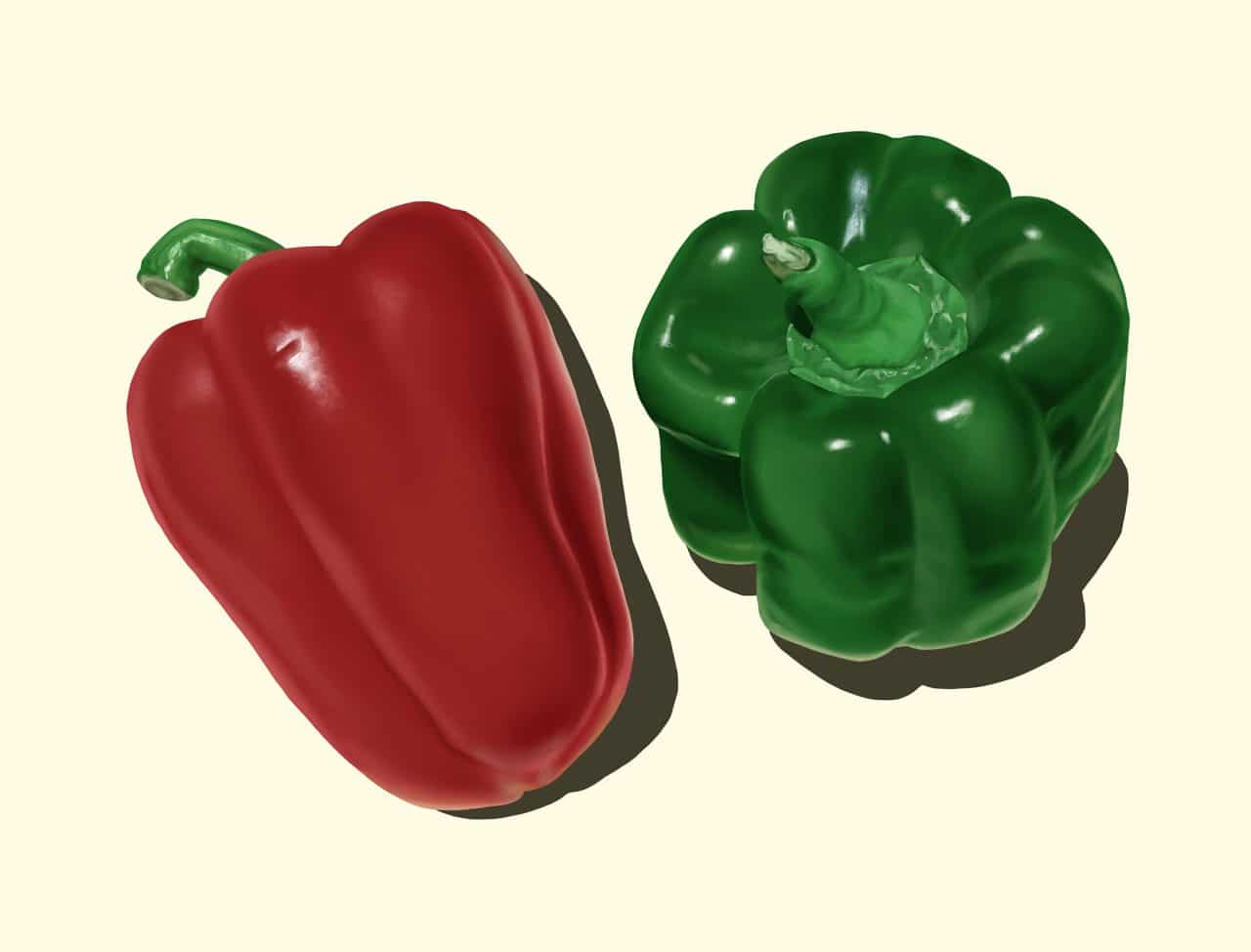Looking to perfect your still-life drawing game? This easy Procreate tutorial is here to help! Read along for a simple yet comprehensive step-by-step guide on how to draw blueberries digitally using iPad Pro.
Digital drawing continues to thrive as an exciting medium in the world of art. Many famous illustrators have created truly remarkable work using Procreate on iPad Pro, and now it’s your turn to try out the amazing tools this artistic medium has to offer.
This realistic blueberry drawing Procreate tutorial will break down the process of illustrating on a tablet and set you up with the basics of this amazing app. We’ll use how to draw blueberries as our example!
How to Draw Blueberries: Drawing on iPad
I’m a Toronto illustrator who specializes in book illustration, portraiture, editorial illustration and exhibition design. Over the last few years the digital medium has become an important drawing tool for me and a integral part of my illustration process overall.
If you are new to digital drawing I am sure you’ll be amazed, both by how easy it is to pick it up, and by the new range of drawing potential it provides. Creating illustrations of everyday things around your home, like blueberries, with an Apple Pencil on iPad Pro, allows for new and advantageous ways of creating layers, texture, and dimension, and is also really quite fun.
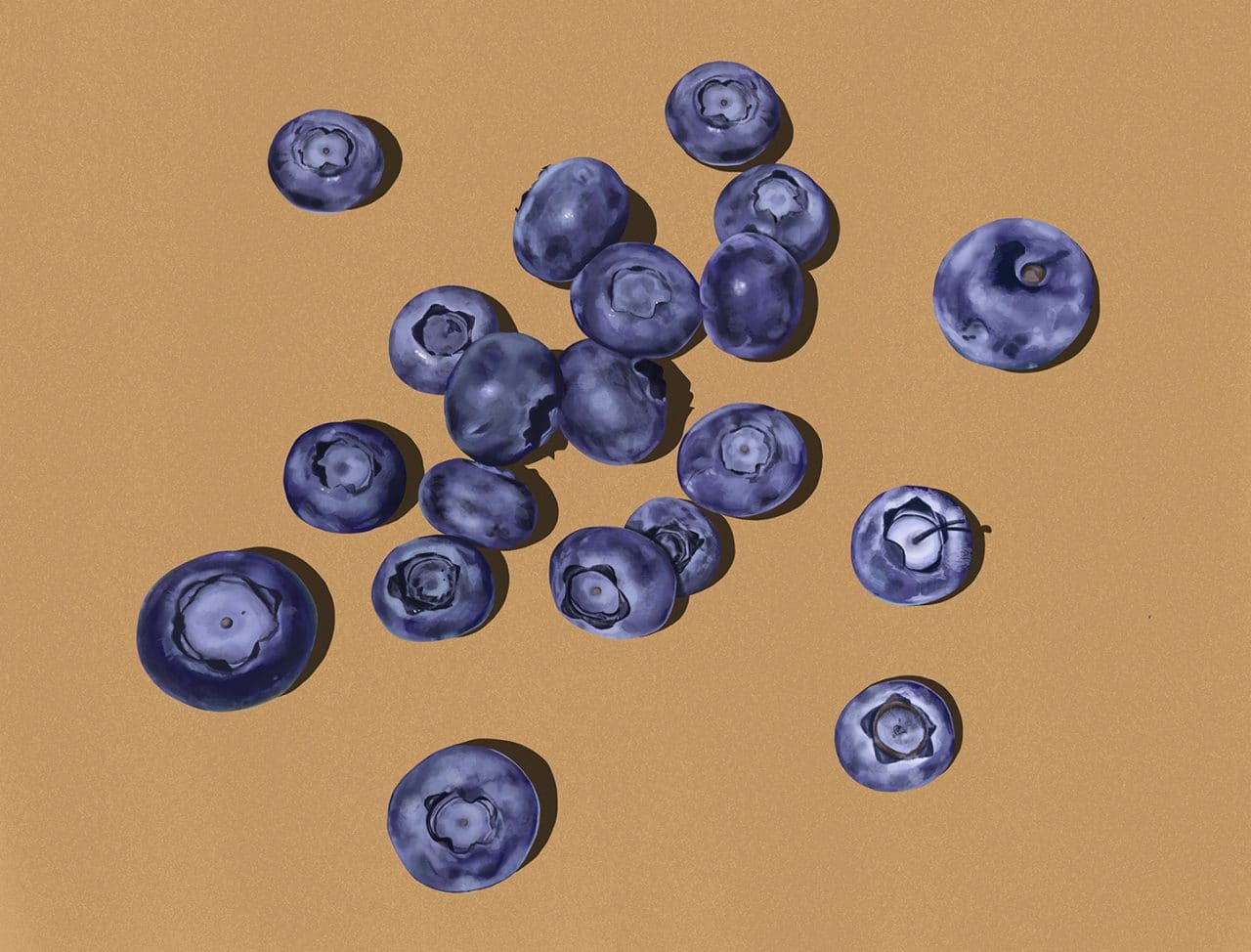
Sketch Realistic Blueberries At Home
One of the best ways to become an expert on how to draw blueberries is by visiting your local farmers market. At my favourite farmers market in Toronto there is an urban farmer who sells beautiful heritage varieties in all different sizes.
Blueberries are a widely distributed and widespread group of perennial flowering plants with blue or purple berries. Commercial blueberries—both wild (lowbush) and cultivated (highbush)—are all native to North America. The highbush varieties were introduced into Europe during the 1930s.
Many commercially available species with English common names including “blueberry” are from North America, particularly Atlantic Canada and the northeastern United States for wild (lowbush) blueberries, and several US states and British Columbia for cultivated (highbush) blueberries. First Nations peoples of Canada consumed wild blueberries for millennia before North America was colonized by Europeans.
Today blueberries are sold fresh or frozen, as a puree, juice, dried or infused berries. They’re also popularly found in jellies, jams, pies, muffins, snack foods, pancakes and as a topping on breakfast cereals.
A diversity of shapes and sizes helps make a still life berry portrait more interesting. Be sure to arrange the blueberries on your kitchen counter to photograph in ample natural light.
You’ll of course need to eat up those blueberries once you’re finished drawing so why not make one of our popular blueberry recipes?
- High Fiber Blueberry Banana Muffins
- Dairy & Gluten Free Blueberry Banana Muffins
- Mini Blueberry Muffins
- Blueberry Earl Grey Muffins
- Blueberry Lemon Muffin Tops
- Lemon Blueberry Muffins
- Blueberry Buck Whiskey Cocktail
- Sour Lemon Blueberry Gin Cocktail
- Blueberry Blue Mojito Cocktail
- Blueberry Mango Crepes with Coconut Flour
- Blueberry Cream Cheese Earl Grey Ice Cream
- Blueberry Lemon Curd Ice Cream
Blueberry Drawing Procreate Tutorial
With a pleasant and palatable taste and sweetness, the blueberry is a much loved fruit staple in many parts of the world. Not only is it delicious, both in its fresh form and as a component in a variety of baked goods, but the blueberry is quite unique because of the source of its namesake – it’s blue.
With the glaring exception of the sky, blue is actually the rarest colour to exist in nature. Blue pigment in plants and animals is very difficult to produce, and in fact many of the blue creatures we can commonly think of (corn flowers, bluejays, some butterflies, etc.) rely on specific molecular structures that cancel out other colours in the visible spectrum, rather than actually “being” blue.
The colour of blueberries, as it turns out, does come from a pigment, called anthocyanin. However this pigment is actually a deep purple colour. So after all this it turns out that blueberries aren’t actually blue either! Though at a glance they certainly appear that way.
Given all this complexity around the actual colour of blueberries, drawing them can be a unique and enjoyable challenge. Luckily for you Procreate makes recreating telltale blueberry features in your drawing fun and easy. And this Procreate tutorial will break down the process into separate steps that will have you creating a still life blueberry masterpiece in no time.
Not to mention, the Procreate methods you’ll practice using in this tutorial will create the benefit of adding many exciting new tools to your art arsenal!
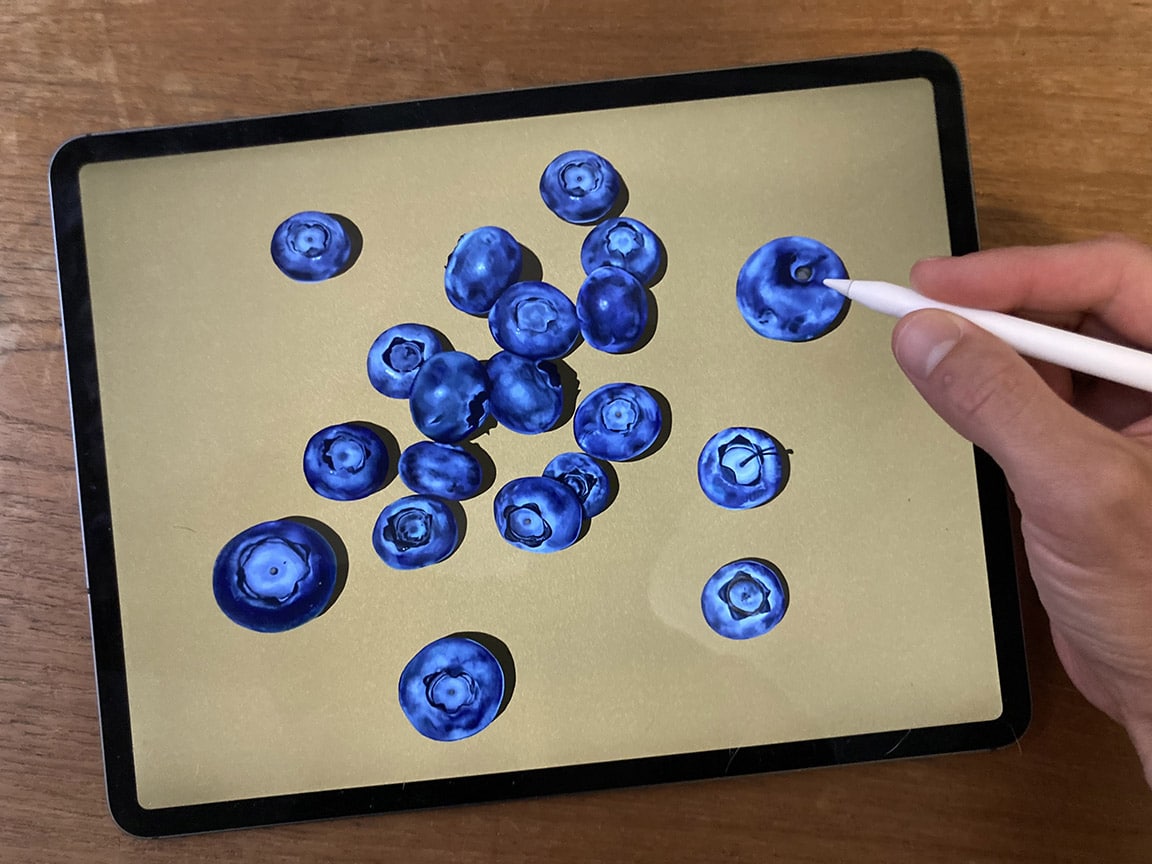
Procreate Tutorial: How to Draw Blueberries with iPad Pro
Let’s first get set up with a new canvas in Procreate. When you first open the app you’ll be in the “gallery” where all of your artworks will be visible. Tap the “+” in the top right of the screen and a menu will appear where you can select your canvas size.
To choose your dimensions click “create custom canvas” and enter them (in mm, cm, inches, or pixels). You can simply select “screen size,” however I recommend going bigger so that you have the option to print your finished piece with a nice resolution.
For my blueberry drawing I’ve created a 11″ x 14.5″ canvas. I’ve gone with a resolution of 300 DPI, which allows for up to 35 layers. If you go too big the maximum number of layers you can have in your artwork can be too few for our purposes, this is a good size.
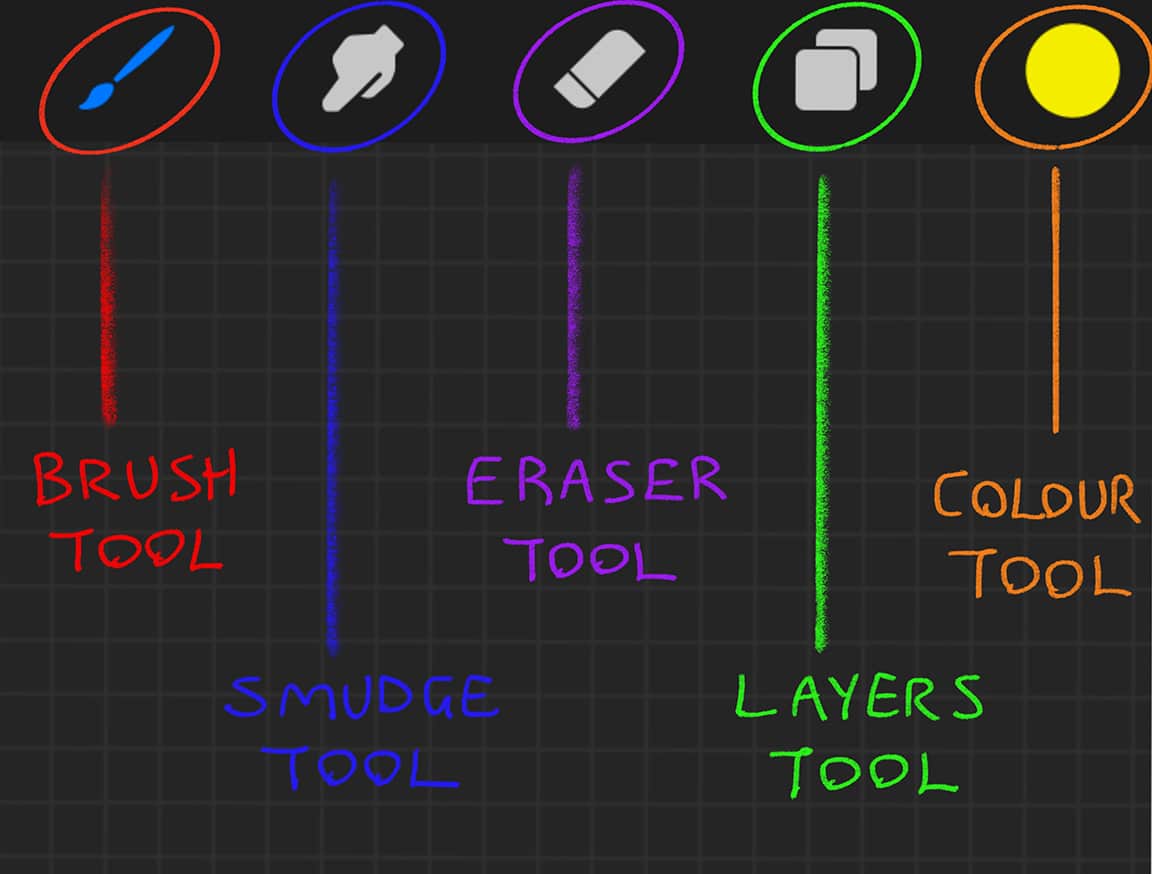
Now it’s important to explore and familiarize yourself with Procreate’s basic tools. Starting with the toolbar on the top right of your canvas.
- The Brush Tool: This is the tool with which you draw/paint. Tap it to open your Brush Library. Procreate’s brushes are categorized in a list down the left side of the drop down menu. Tap any of these to see your brush options in each category. Choose what you like and then tap the brush icon in the toolbar again to close the menu. Now get scribbling! Try a few different brushes and use different pressures and angles of the Apple Pencil – it’s remarkably realistic in its response to your hand.
- The Eraser Tool: It does exactly what you think it does! Tap it and you’ll open an identical Brush Library as tapping the brush tool. Try a few and see how it erases your scribbles.
- The Colour Tool: This is your colour palette. Tap and it will open in its default view of “Disc.” Use the outer wheel to select colour, and the inner circle to select lightness/darkness. Or you can use the square view that combines the two. When you’ve chosen the colour you want to use, tap the colour icon in the toolbar again to close the menu. Again, do some scribbling! Choose a variety of brush and colour combinations to get a feel for the colouring process.
- The Smudge Tool: This is used to blend colours and create gradients. This tool has the same effect as taking your finger to pencil on paper and rubbing it to blend. The smudge tool mimics the real thing fairly well but it does take some getting used to.
- The Layers Tool: You can use this menu to create multiple layers on your canvas, and select between them. How to do this, and the benefits of layers, will be best understood by following through my own example here in this Procreate tutorial.
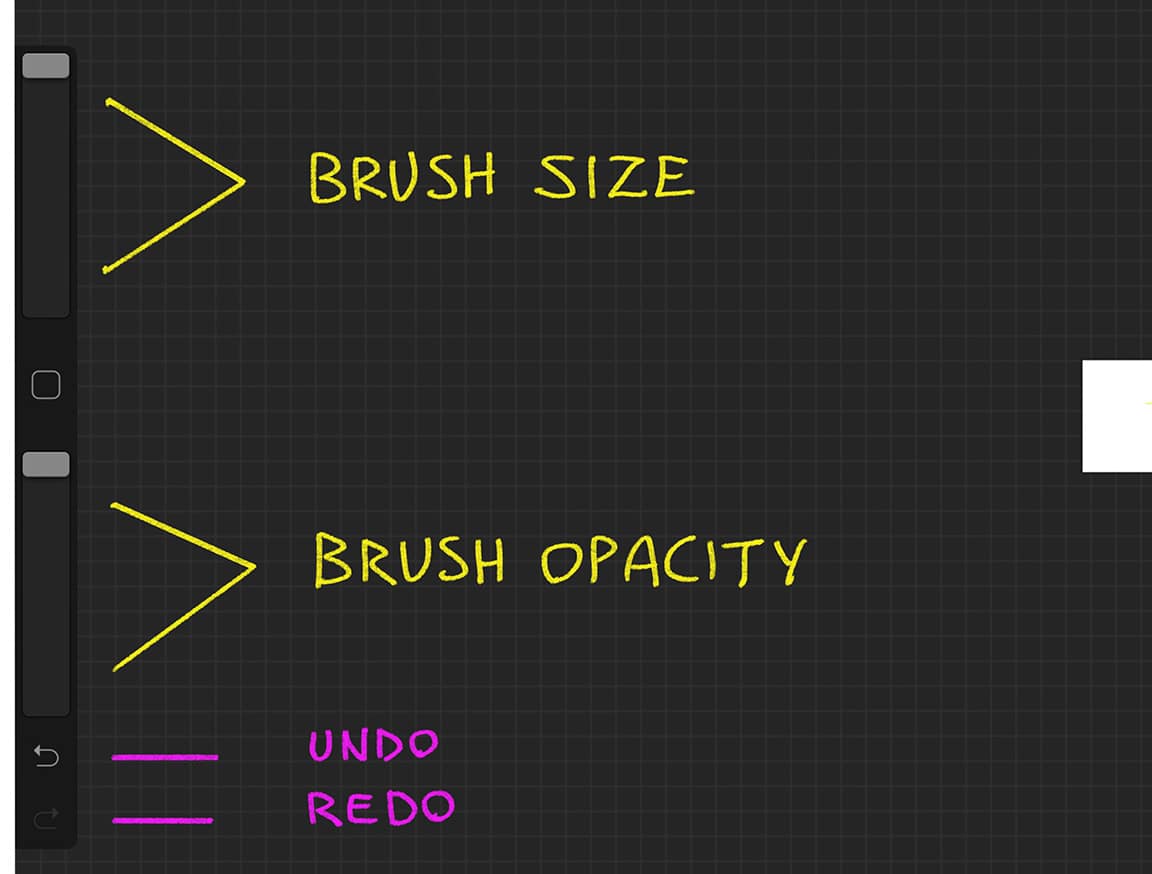
Then there are the slider toolbars on the left side of your canvas.
- Brush Size: The top slider. Tap, hold and move up and down to adjust the size of your brush tip. A preview window will open up to help guide you. This slider is used for your brush, smudge and eraser tools in the same way.
- Brush Opacity: The bottom slider. This works the same way as the brush size slider, but is for brush opacity.
- Undo/Redo: Under the sliders you’ll see these two buttons. Tapping the undo button will undo the last stroke you drew/erased. Vice versa with the redo button. This is a very useful tool you’ll probably use a lot. You can also undo by tapping once anywhere on your canvas with two fingers.
There is also the toolbar in the top left of your canvas. For these tools I will point them out and explain them along the way as we need them.
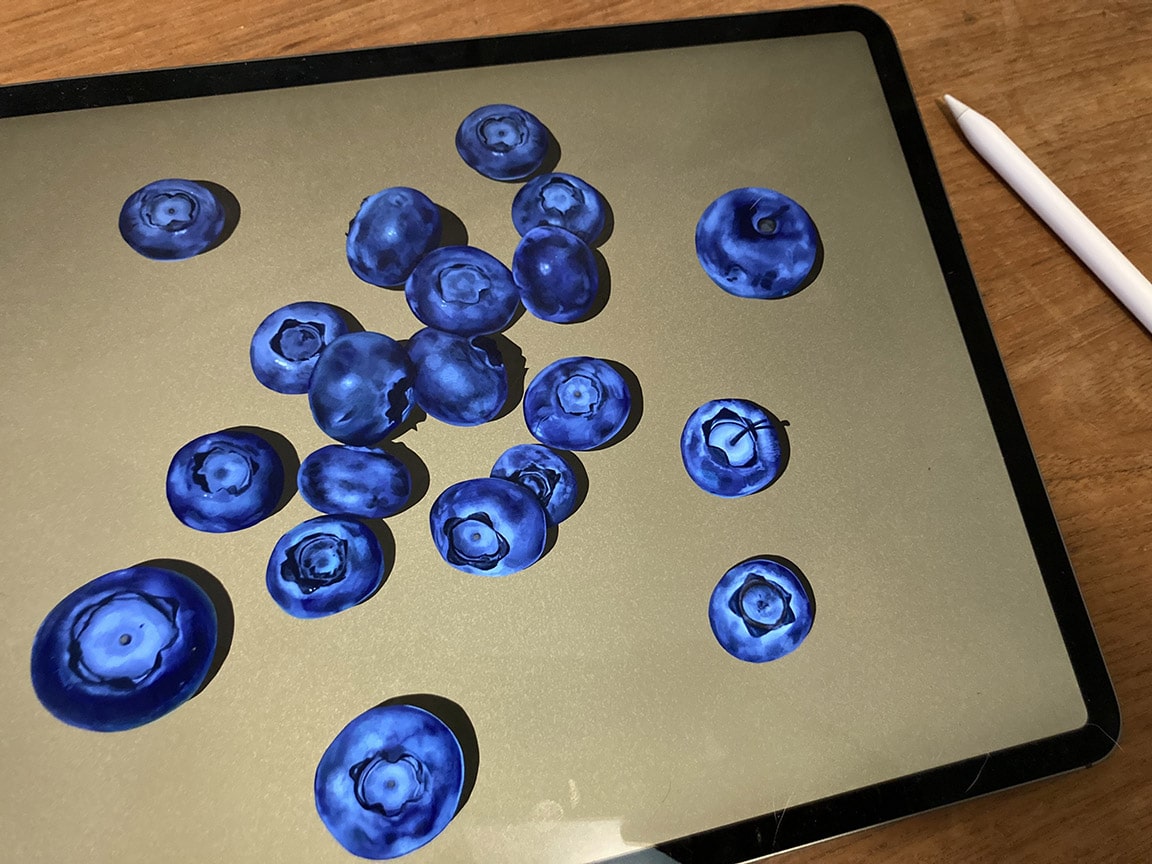
How to Draw Blueberries Step One: Choosing a Reference Photo
If you can take your reference photo yourself, great. You can use the iPad itself to capture a good photo.
If you don’t have any blueberries handy, there are plenty of images online for you to choose from. It’s a good idea to chose one that is copyright free and there are several websites that have large libraries of free images.
I took my reference image myself in my kitchen. I thought I’d include a small handful of blueberries, since that’s how I usually think of them, in multiples.
Blueberries can have an interesting sort of shine to them from their “bloom” which is the white powder that coats their skin. Packaged and washed blueberries usually don’t have much of this natural protective coating left, however I found a few that did. I made sure my photo angle captured the light reflecting off their bloom nicely.

The first thing to do before you get to drawing is setting up your reference photo to work from. A great option with iPad Pro is that you can keep your photo open in a window beside your Procreate canvas while you work.
To do so, tap and hold the bar at the bottom centre of the screen in Procreate, then slowly pull up the iPad menu (if you swipe too quickly you’ll close Procreate).
Once the menu is up, tap and hold the photos icon, and drag it to the left side of the screen (or right side, for the lefties out there!) Pull it past the edge of the Procreate window and drop it there and tada, you have both open at the same time. You can also adjust the size of the photo window by holding and sliding the side bar of the window.
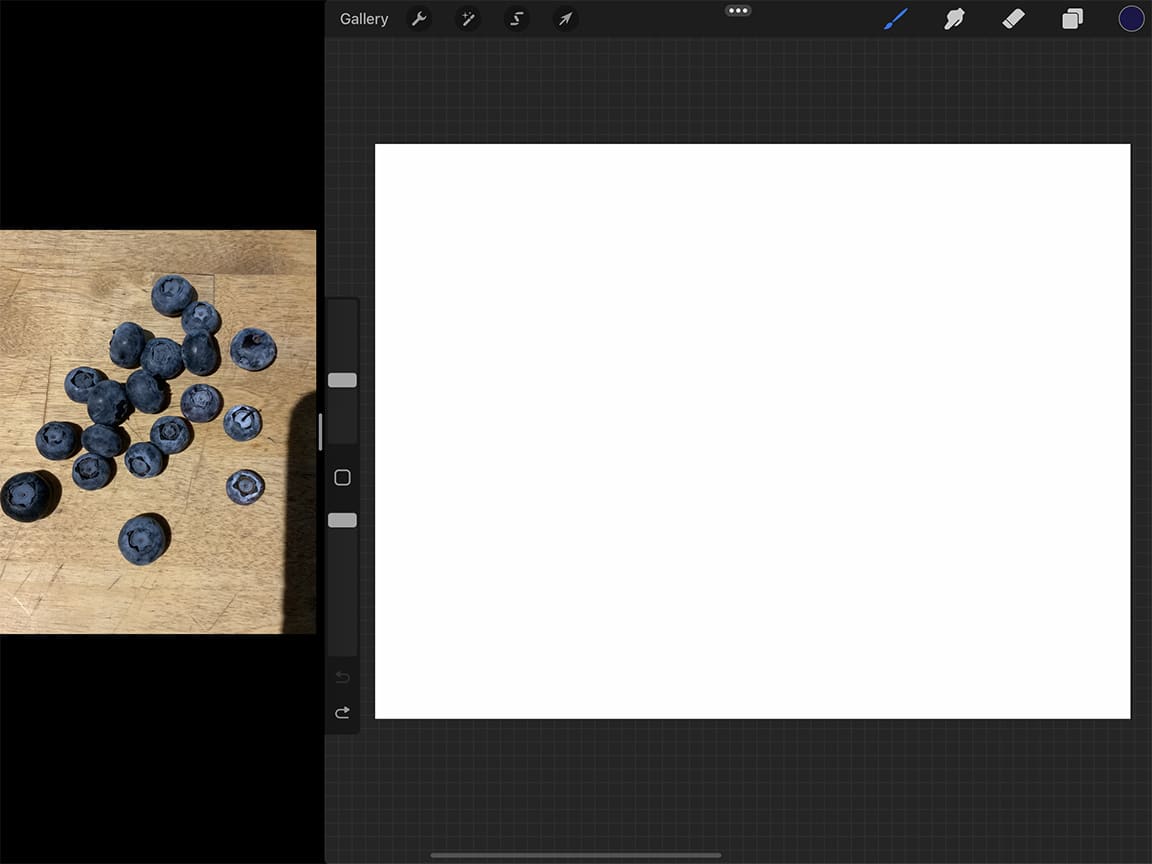
How to Draw Blueberries Step Two: Blocking Your Shapes
Now you are set up to start drawing blueberries!
The first step will be blocking out the shapes of the individual berries with a solid colour. For this I used the studio pen brush under “inking” in the brush menu, because it gives a nice clean line.
To determine which colour to use, I took a look at my blueberry reference photo and tried to match it generally to the darkest colour tone of the berries. Your outline does not need to be perfect by any means (part of the beauty of drawing a fruit is that it is naturally imperfect!)
Once you have a fully enclosed shape, you can fill it in with solid colour by tapping and holding the colour icon in the top right, and then dragging it to the inside of your shape and releasing. The shape will then fill with that colour. Make sure your shape is fully enclosed or the “fill” will fill the entire canvas. If this happens just tap your canvas with 2 fingers to “undo.”
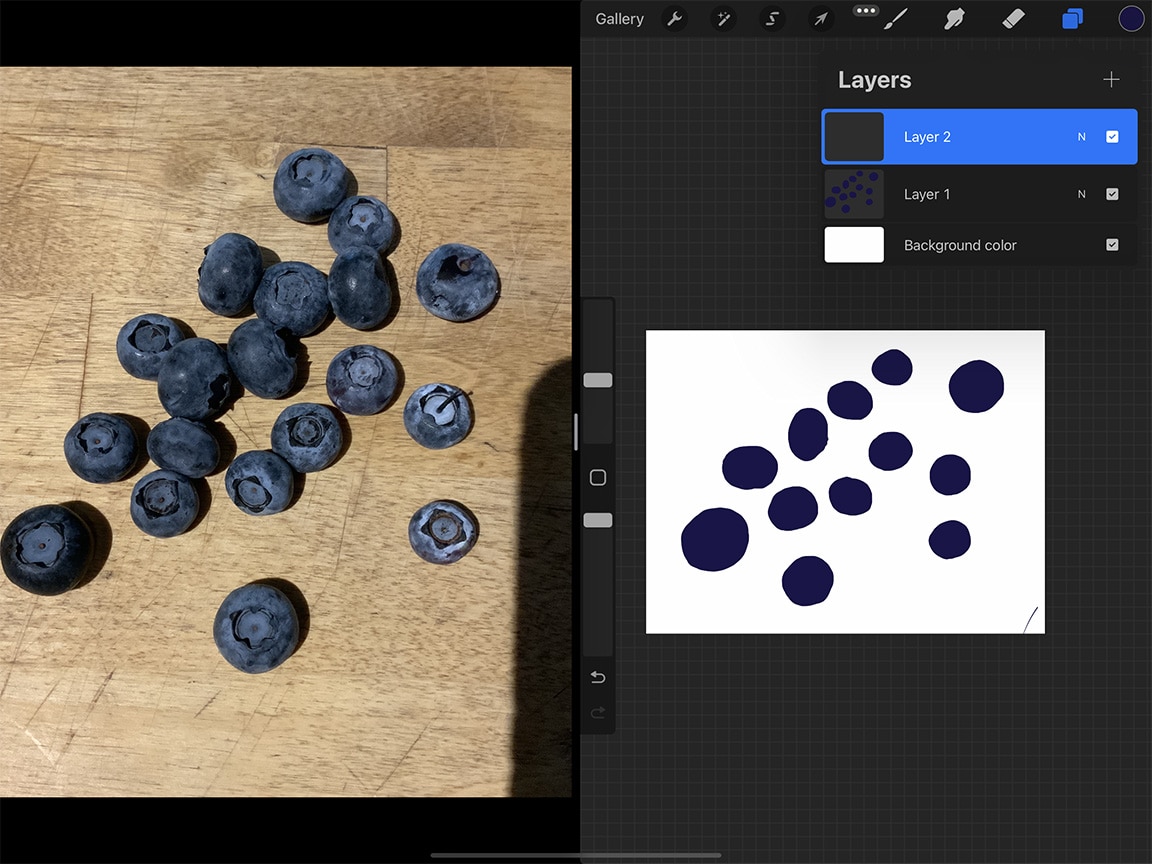
You may find it helpful to separate these shapes onto separate layers. For my drawing, anytime a berry was touching another I would try to make sure they were on separate layers. This will make painting and editing them much easier down the road because you won’t have to worry about your painting bleeding from one berry to another.
To create a new layer tap the “layers” icon in the top right menu, and then tap the “+” in the drop down. You can tap and hold any layer in the menu and drag it above or below other layers.
You can adjust the size and position of different elements in your blocked shapes by utilizing the “lasso” tool. That is the tool in the top left menu that looks like the letter “S”. Tap it, and then make sure “freehand” is highlighted in the bottom menu. Then you can use your Apple Pencil to draw around the part you want to adjust.
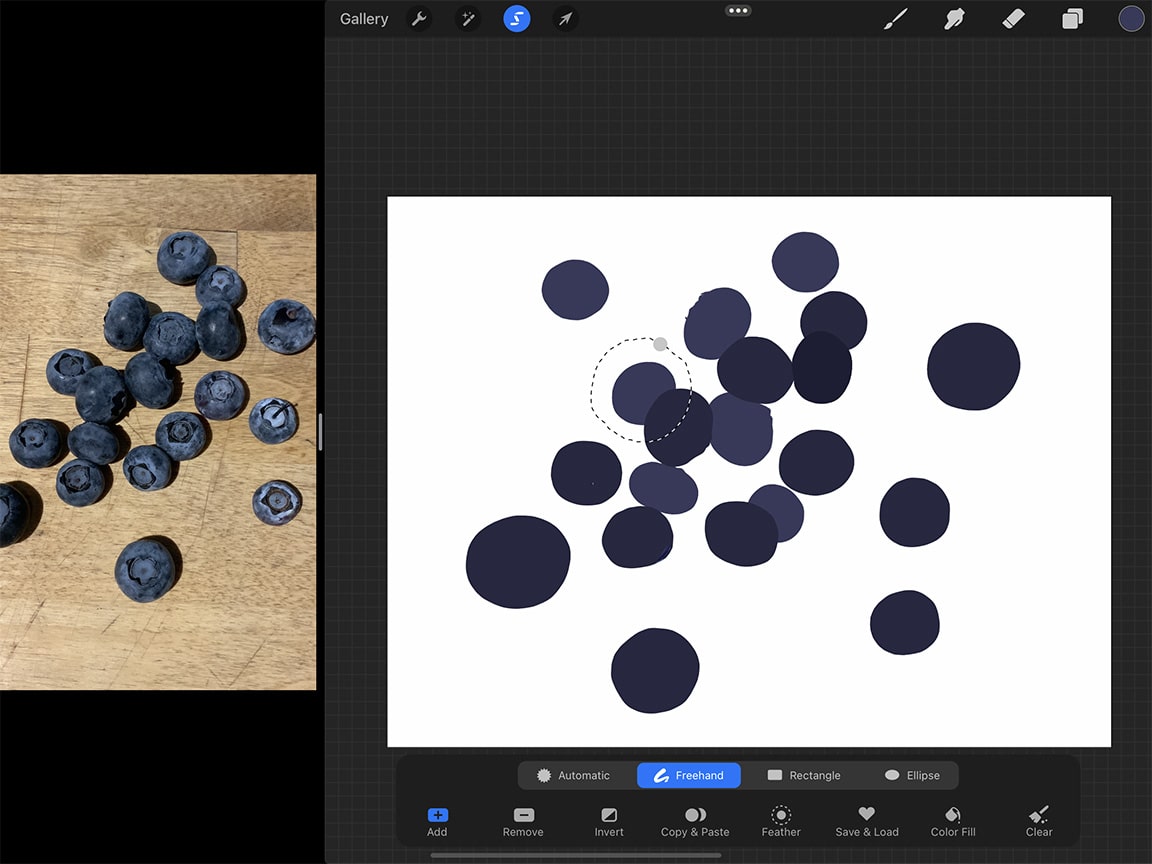
One you’ve traced around that portion, tap the cursor tool in the top left menu and you’ll see a bounding box appear which you can use to make adjustments. For example, I adjusted the size of a few of my berries after the fact, making them smaller or in some cases rounder.
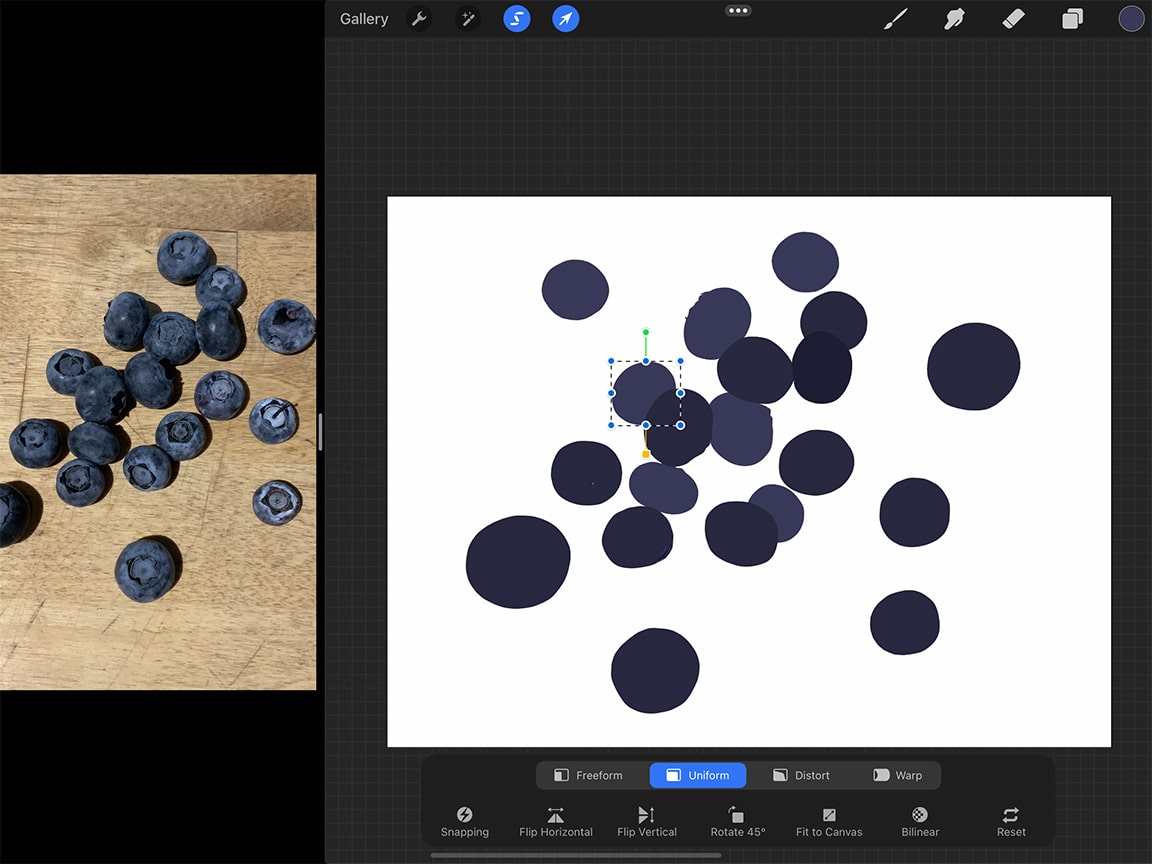
How to Draw Blueberries Step Three: Underlying Gradients
Now that you have your base layers of colour you can start “painting” and adding layers of colour to build up the texture and details of your blueberries. Take a good look at your reference photo and try to see the underlying gradients of light and dark tones beneath all of the finer details.
Before you begin though, Procreate has a feature that makes this painting and blending part a lot easier, called the alpha lock. If you “alpha lock” a layer, you can only paint on what already exists on that layer. Meaning when blending out some colours you don’t need to worry about your smudges coming past the edges of you blocked out shape.
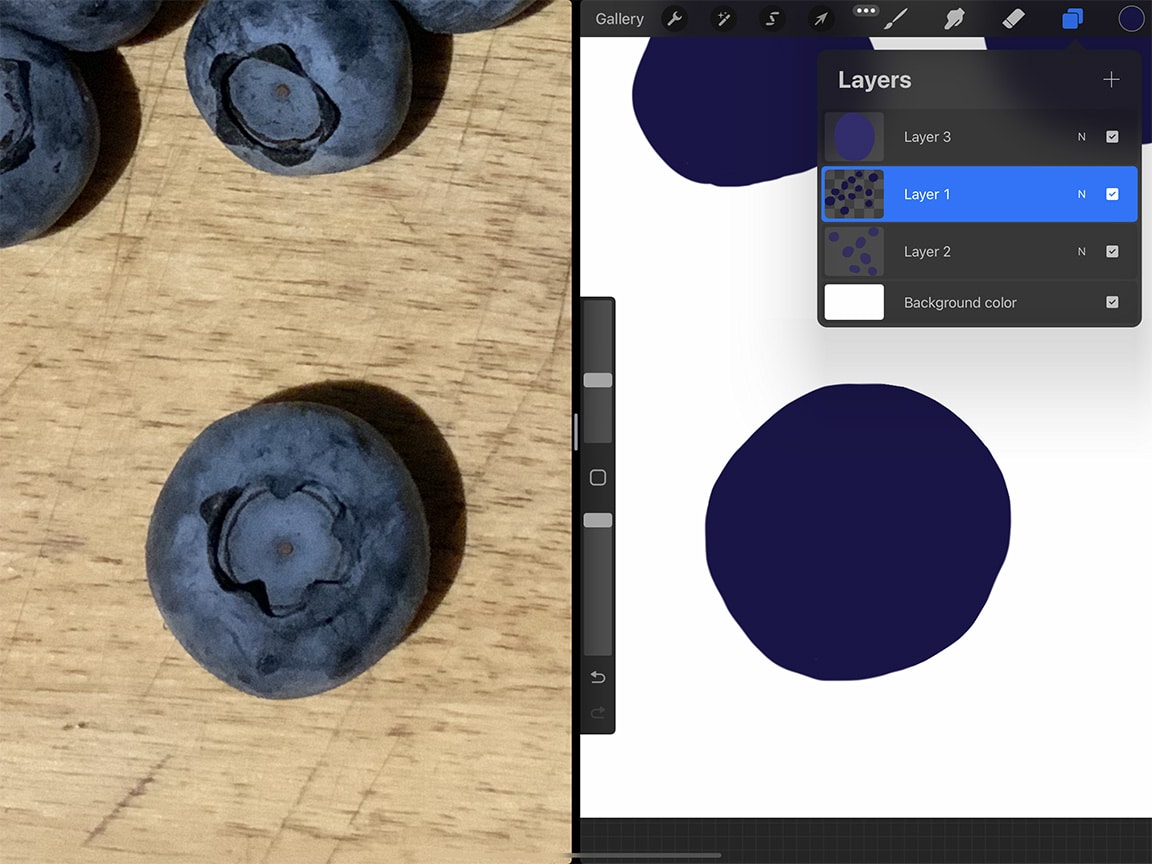
To alpha lock a layer, open the layers menu. Using two fingers, swipe the layer you want to lock to the right. If you’ve done it successfully the layer thumbnail will get a checkered background. To un-lock the layer at any point simply swipe it with two fingers to the right again.
Now you can get to painting. For my drawing I started with one single berry first to get my process down.
For this part you do not necessarily need to be very tidy with your painting. You can roughly paint out lighter and darker areas and then blend and smooth them out using the smudge tool. For blueberries I would recommend using the smudge tool very sparingly though. The different blue tones on the berry skin is quite patchy and overly smudged blending would look too smooth.
For this part I chose the “gouache” brush under “painting” in the brush menu, just because it seemed to mimic the texture of the blueberry skin. Feel free to use whichever brush suits you though.
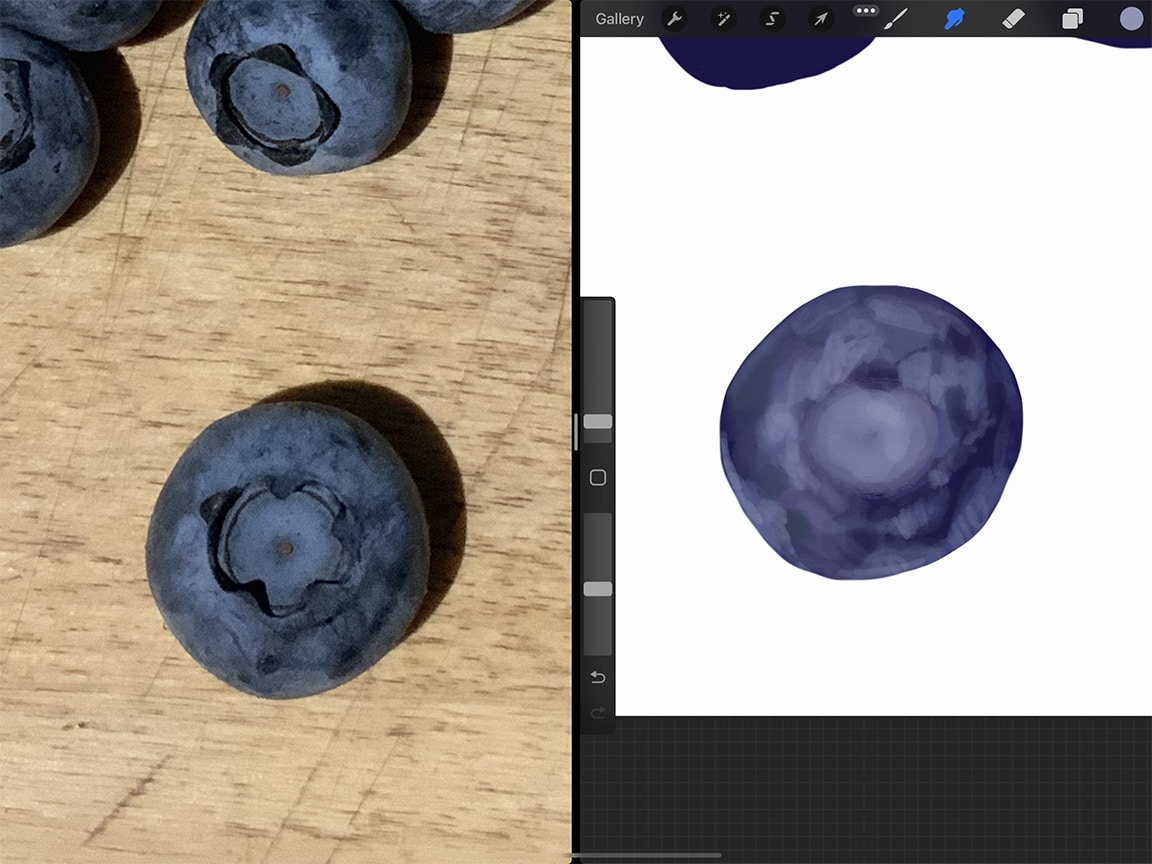
Feel free to experiment with different brush tips for different effects. Or even just changing the brush size for some nice variation in texture. For example, to create some of the spotty patches, I selected the “wet acrylic” brush, and played with the brush size to gently add some of the rougher texture to the skin.
Play around until you have a gradient of colour that primarily creates a three-dimension look when zoomed out. Remember all of the crisp and fine details will be added on top once you are finished this part.
During this step it’s a good idea to work generally from darkest details to light. Meaning you finish off with the shiny highlights. To create a realistic shine zoom in and really look at the reflective area.
There are often colours in there you may not expect. For example I found myself moving closer to the green side of my blues for some patches of skin, when I would have thought the tones would all be on the purple end of blue. Build up the highlights saving pure white for only the brightest bits and spots.

How to Draw Blueberries Step Four: Finer Details
Once you have the underlying changes in tone finished on the blueberry skin, you can next put in the crisp details of the blossom portion on the top of the berry. I would do this drawing again on a new layer so that you don’t affect your underlying colours while you edit it. I used the same gouache brush to draw this part, just shrunk down to the smallest brush size.
Make sure you pay attention to where the highlights and lowlights are surrounding these details on the top of the berry. You can then switch back and forth between the skin layer and the detail layer to keep drawing until you are happy with the result. Remember it is often helpful to zoom in quite close on both your drawing and on the reference for this part.
The final detail to add is the small brown dot where the berry stem once attached. You can draw this on the detail layer as well.
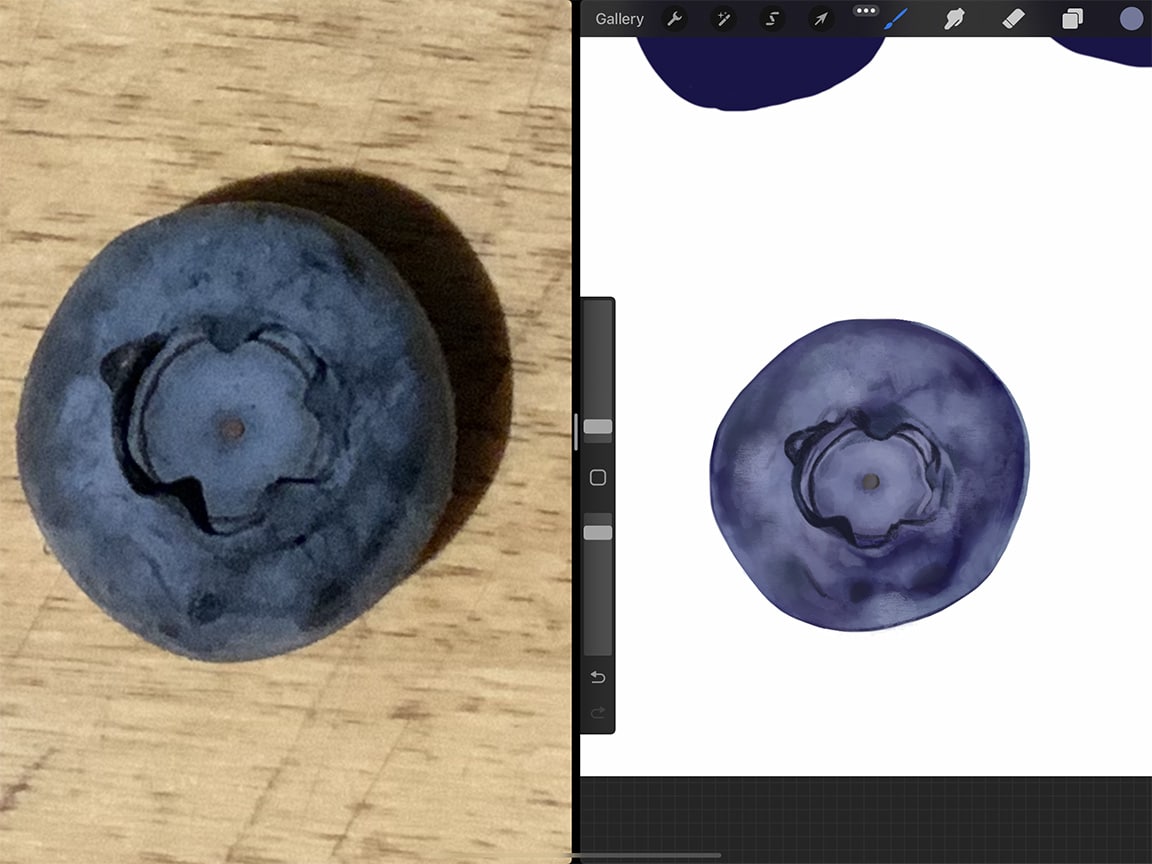
How to Draw Blueberries Step Five: Repeat!
Now that you have your process down for drawing your first blueberry, you can go through and repeat this process for all the rest of the berries in your drawing. I decided to focus on one layer of berries at a time, and went through each step of painting out the skin on all of them before moving to the next colour or step. That was just my preference though, if you prefer to completely finish each berry before moving on to the next one that is perfectly fine too.
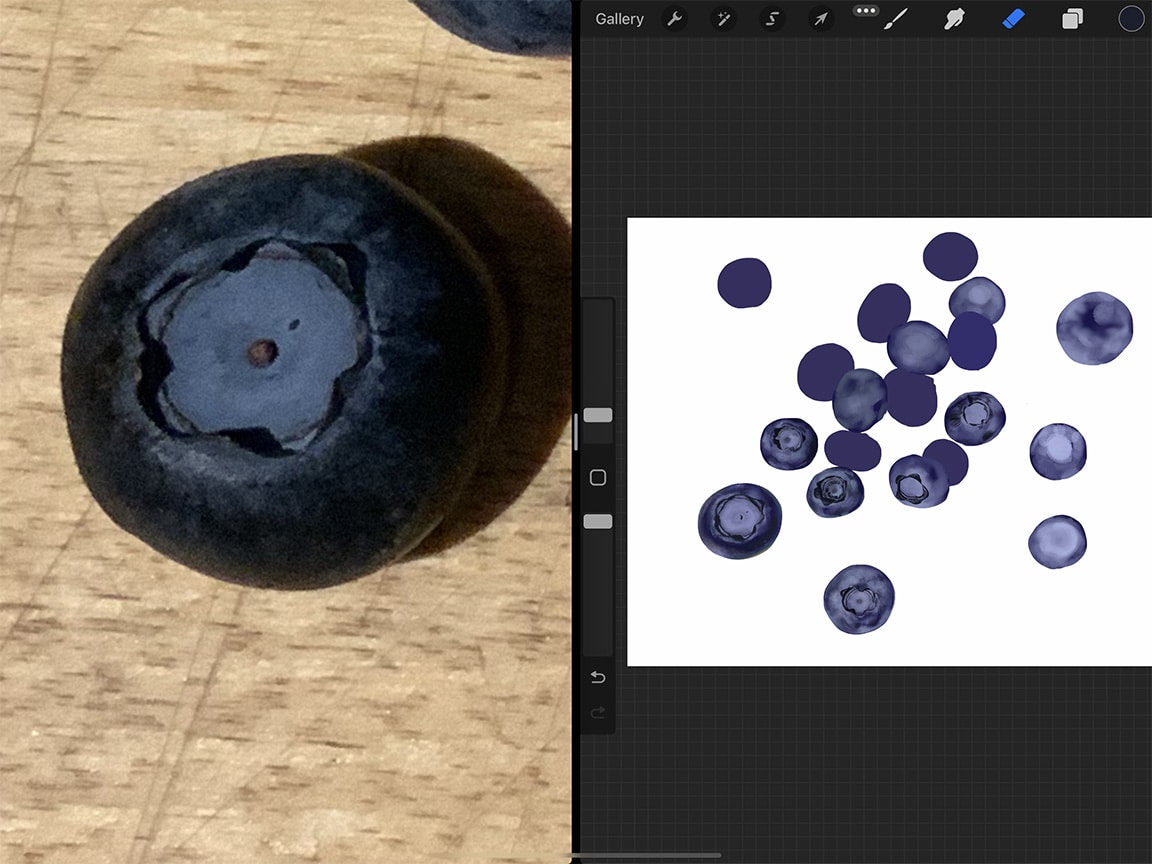
Toward the end of this part of my drawing, I may have regretted including so many individual berries. So to give myself a break I will share a little cheat you can use in a scenario like this.
Rather than draw out my final berry, I just made a copy of one of my existing berries and flipped it, so that it didn’t look exactly the same.
To do so, choose the berry you want to copy. You’ll then need to select all of the layers that make up that berry. To select multiple layers, open the layers menu and then swipe each layer you want to select to the right using one finger. The layers will highlight in blue when they are selected.
Next select the lasso tool again, and draw around the berry you are copying. Once you’ve done that tap the “copy and paste” option in the bottom centre menu. Procreate will copy your selected berry and add the copy to its own new layer.
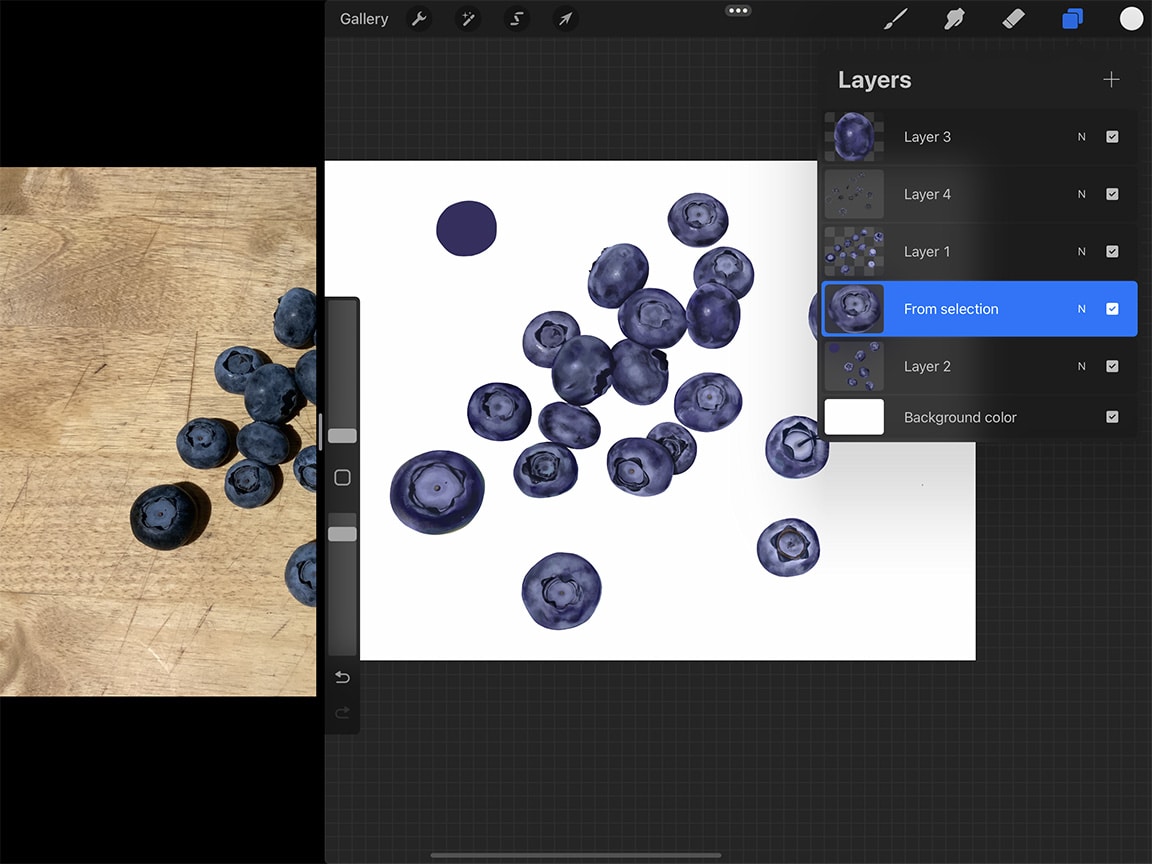
Then you can select that new layer and move your copied berry into place by tapping the cursor icon in the top left menu. You’ll also see the option to “flip horizontal” when the cursor is selected so you can flip, rotate, and therefore make it less obvious that it was a copy.
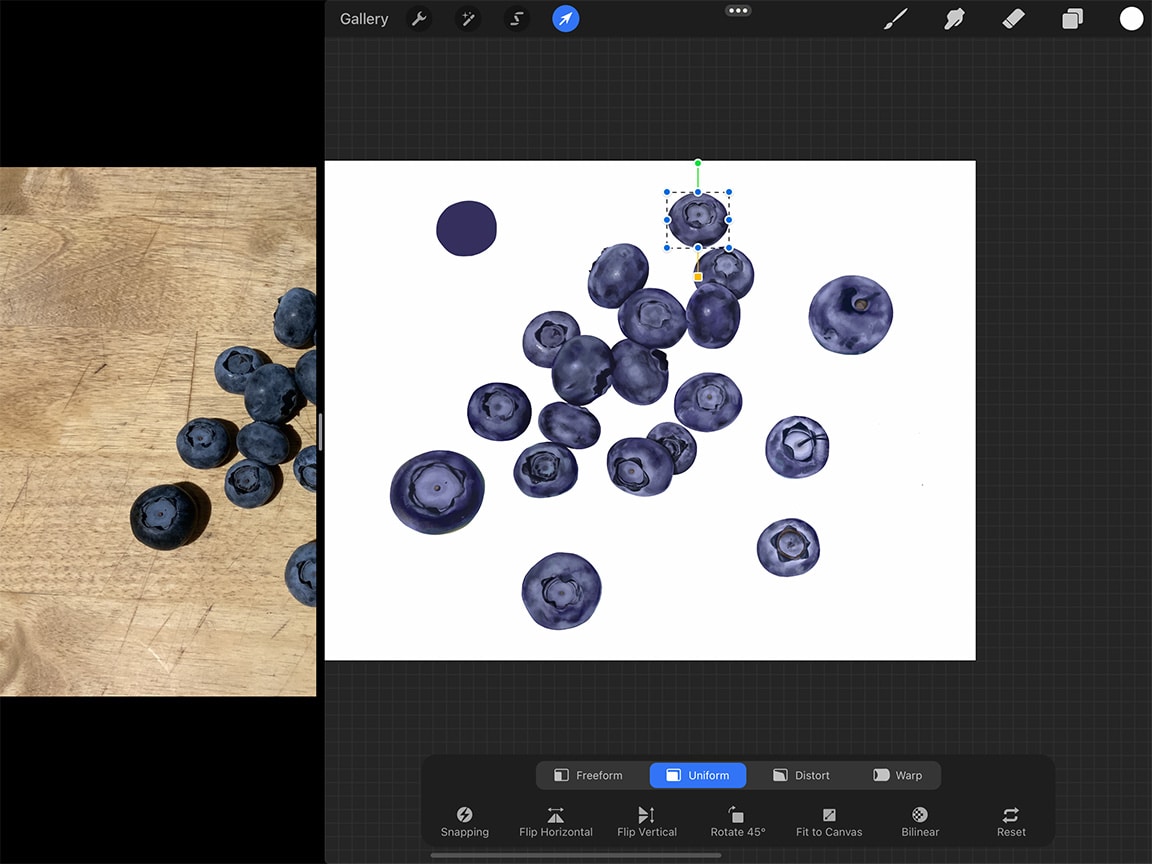
How to Draw Blueberries Step Six: Shadows
Finally, to complete the drawing I added some shadows to ground the blueberries.
For these, it’s first important to choose your background colour, because your shadows will be a darker shade of that colour. You can do so by opening the layers menu and tapping the “background colour” layer. I chose a rusty orange colour because I thought it complimented the deep blues and purples of the berries. But this part is up to you, so choose whatever colour you like!
Now to do your shadows, once again start on a new layer positioned below the berry layers. Draw out your shadow shapes with a clean-edged brush (like the technical pen) and fill them in with a dark, nearly black shade of your background colour. Then you can use the layer’s opacity to make them slightly transparent to let the background colour come through.
To do so, open the layers menu, then tap the “N” on the shadow layer. Then you can adjust the slider to the transparency of your liking.
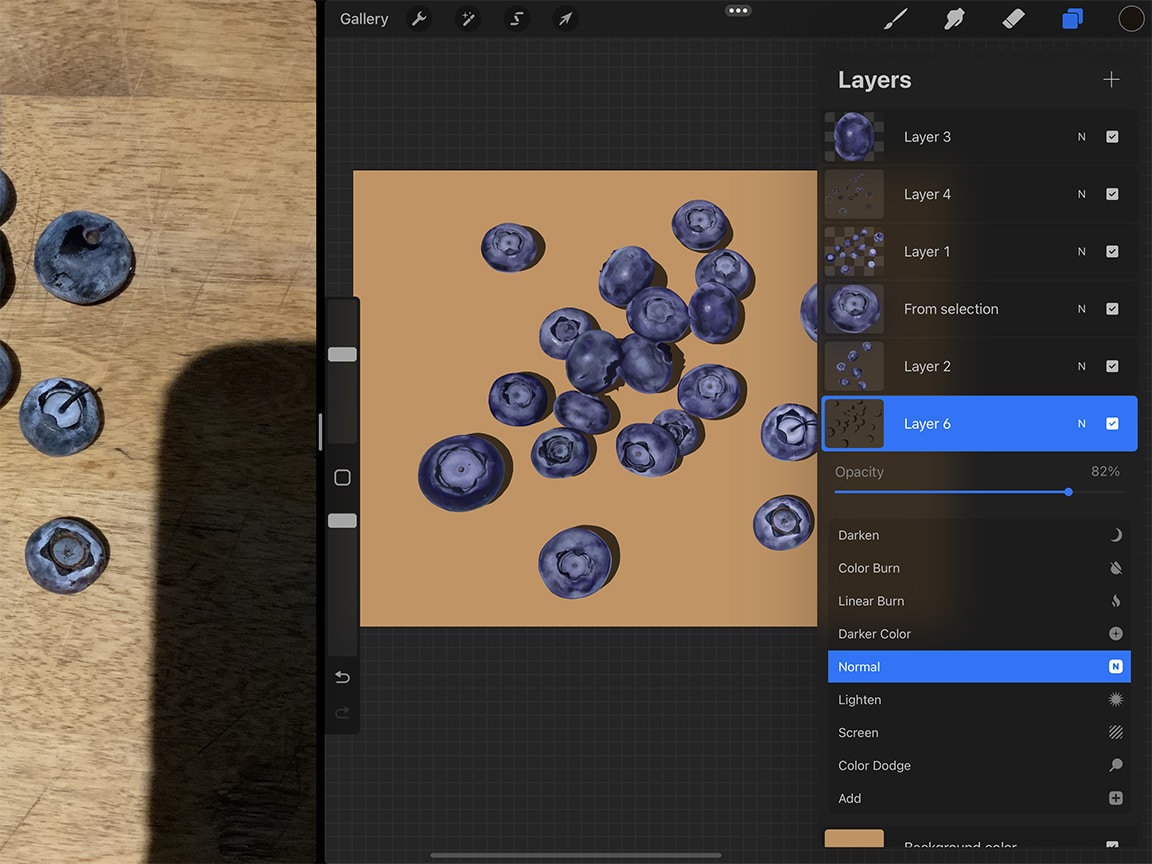
Helpful tips:
- To return to a colour you’ve already used, tap with one finger on the area with the colour you want to reselect, and hold. A magnifying circle will pop up and you can move that to the exact colour spot you want. Lift your finger and it will select that colour for your brush.
- You can zoom in and out by “pinching” the screen with two fingers. Don’t forget you can zoom in for areas with small details. You can also rotate the canvas using the two-finger pinch (rather than turning the iPad itself around, an inevitable habit when you’re used to turning your piece of paper around – there is an easier way!
You May Also Enjoy Reading…
- How To Draw Carrots
- How To Draw Pears
- How To Draw A Broccoli
- How To Draw a Lemon
- How To Draw A Candle
- How To Draw Tomatoes
- How To Draw an Orange
- How To Draw Potatoes
- How To Draw Fish
- How To Draw Mountains
- How To Draw A Cottage
- How To Draw A Bottle
- How To Draw Shoes
- How To Draw Realistic Animals
- How To Start a Vlog: Purchase the Best Equipment for Vlogging
You’ve Completed our Realistic Blueberry Drawing Tutorial!
You’ve now mastered how to draw blueberries!
If you’re someone who draws or paints a lot, you know it’s possible to keep going and going and tweaking and tweaking into eternity. And truthfully Procreate makes falling into this even easier.
The up side, however, is that you can leave the piece alone for a time, and then very easily pick up where you left off, without having to get all of your paint and supplies out.
All that said, you will know when it’s done, and for a satisfying finish to your digital drawing experience, you can utilize one of my favourite Procreate features – time lapse video.
By default, Procreate records your entire drawing process (you can opt to turn this off, but really why?) You can play it all back in high speed when your drawing is complete. It’s a fun thing to watch and a fantastic thing to share with curious fans of your art.
If you’re a freelance illustrator, find that offering a time lapse video of your clients’ work acts as a competitive advantage. And better yet, offering a video that showcases the creation of your blueberry drawing requires no additional time or money.
By using this Procreate tutorial as your step-by-step drawing guide for how to draw blueberries, I’m sure you will be very satisfied with your result. Once you’ve gone through the motions from start to finish you can experiment and settle into your own process.
This medium has so many possibilities that you can really let your creativity run wild. So dive in, go digital and have fun!
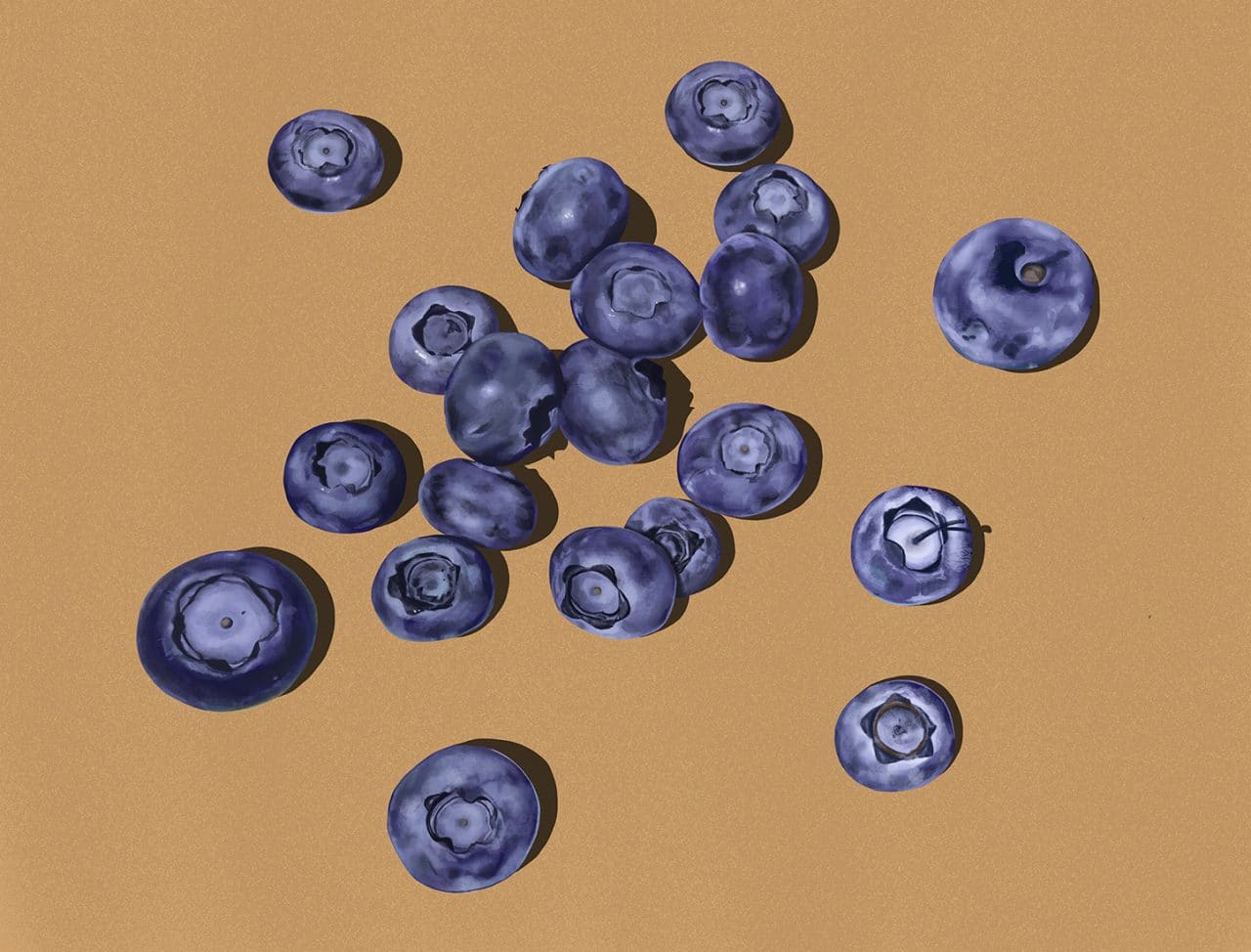
Best Illustration Apps
This story offers a step-by-step Procreate tutorial on how to draw blueberries. It’s important to note that there are several other drawing apps you can use on iPad Pro when drawing blueberries. Here are just a few:
- Notes: The Apple sketch app that comes with your iPad! Simple, easy to use for quick sketches, free and fast. Though for serious drawing you may want to seek apps with more robust options/tools. Price: FREE
- Adobe Illustrator Draw: This app is for creating vector graphics, with a very intuitive interface. It can also sync with Adobe’s Creative Cloud, meaning you can transfer your work between the iPad and desktop no problem. Price: FREE with Creative Cloud subscription, monthly plan prices vary.
- Inspire: Fast and nicely responsive, with a huge variety of customizable tools, and over 80 brushes. Great for beginners and intermediates alike. Price:$13.99 CAD, $27.99 for Pro Version.
- Procreate: Easily one of the most popular drawing apps, it works seamlessly with Apple Pencil, is highly responsive and offers an excellent variety of tools, all presented in a terrifically simple interface. Price: $13.99 CAD
If you’re a newbie digital illustrator we also suggest purchasing Beginners Guide to Digital Painting in Procreate, iPad and iPad Pro for Dummies, a protective iPad cover and Apple Pencil Case.
Procreate Tutorial: The Benefits of iPad Pro
- The process is very similar to drawing using traditional methods on paper. You’ll be delighted by how intuitive it is, and how for the actual drawing part, you don’t need to re-learn anything.
- Streamlined process. All of your supplies – camera, reference photos, paper, pens, pencils, eraser, pencil sharpener, paint and paint brushes, are all combined into one place – iPad Pro and the Apple Pencil.
- The ability to undo when your pen stroke wasn’t quite right. You can also edit certain elements after the fact. The thickness of that piece is too much, I don’t quite like the colour I used here. All of that can be fixed!
- The ability to work in layers, drawing or colouring over or under certain elements without worrying about accidental erasing or colour contamination.
- You aren’t tethered to your desk, you can get comfy and work wherever you like. And that includes outside your own home too.
- Easy transferability/sharability of your art. Your finished product is already in a format that you can add to your illustration portfolio online, share on your social media, etc. No need to arrange a high quality scan or professional photograph.
- The ability to replicate elements, (for patterning, for example) rather than needing to hand-draw the same thing over and over.
If you’re a freelance illustrator looking to up your game, getting familiar with this medium will benefit you tremendously. And if you are an amateur who just loves to draw, looking to have fun creating blueberries or other still life drawings, iPad Pro and Apple Pencil can help you do things you might not have thought possible.
Some of the links in this story use affiliate links. This means that if you make a purchase through our site, Dobbernationloves will earn a small commission at no extra cost to you. Your support helps us to produce comprehensive content.


